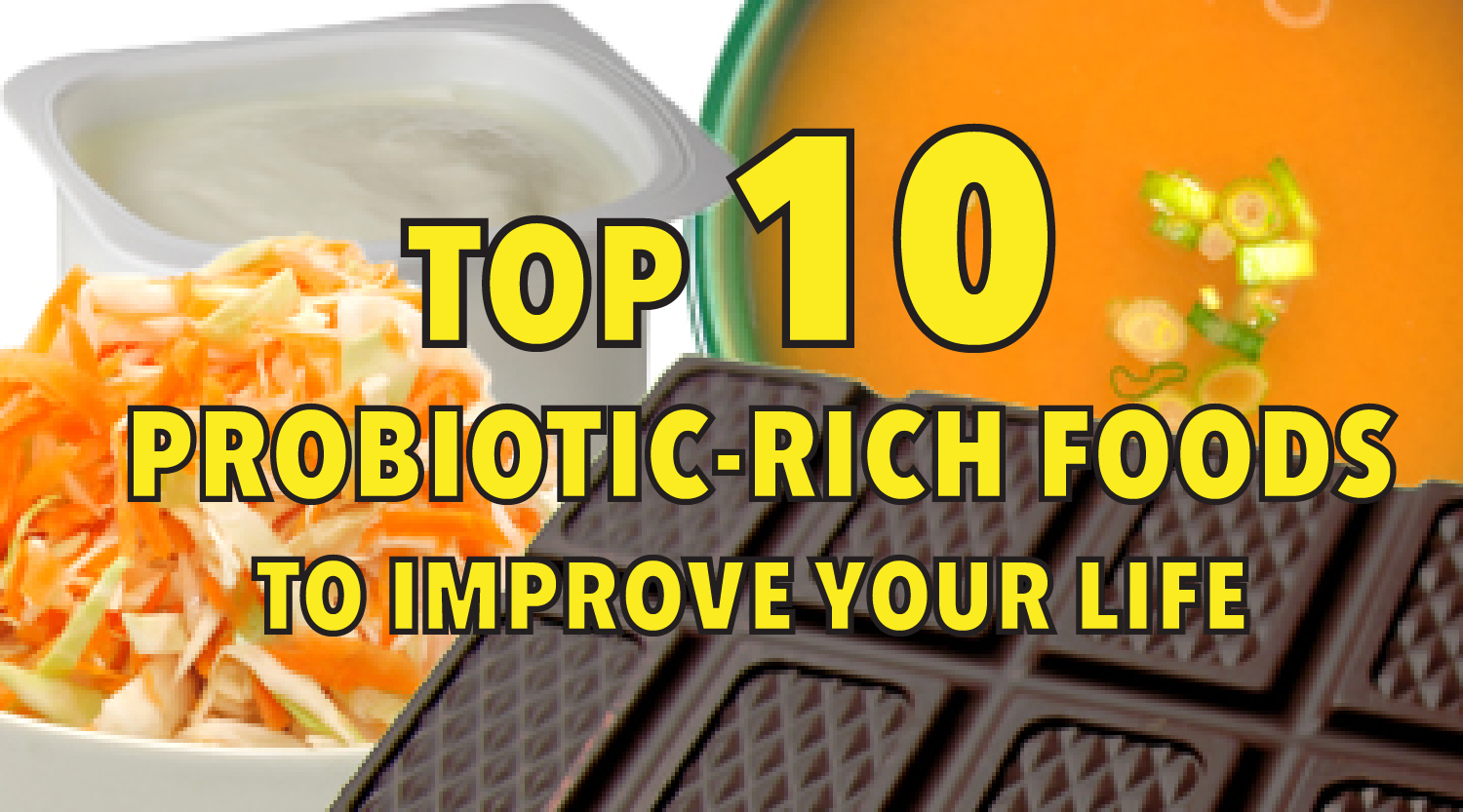Probiotics benefit the digestive system by keeping your gut healthy with good and helpful bacteria such as Bifidobacterium, Lactobacillus and Bacillus subtilis. These bacteria can be found in fermented foods and are known to improve the activities of digestive enzymes. Eating probiotics in your diet can help treat conditions such as inflammatory bowel syndrome, skin conditions such as eczema, yeast infection and other digestive problems.
Probiotics have been used for thousands of years. Kombucha is an ancient probiotic drink which is believed to have originated in China around 5,000 years ago. Tibetan nomads of the Qinghai–Tibetan Plateau rely on yak’s milk which is full of bacteria that has probiotic activity.
There are many ways to include probiotics in your diet ranging from soups to tangy side dishes. If you do not have a yak on hand, then perhaps you can find other probiotic-rich foods to supplement your diet. Below we have compiled the top 10 probiotic-rich foods to improve your life.
Yogurt
Yogurt is made with basic cultures and probiotics that can keep your digestive system and gut healthy. According to WHFoods.com, eating probiotic yogurts “has also been show to help steady the passage of food through our digestive tract and to lessen the risk of certain digestive problems (such as diarrhea).”
When shopping for yogurt, keep in mind that sugary and processed yogurts are not going to deliver great nutritional benefits. As with any food items, it is best to stick to organic, even with yogurt. Organic products have a lower risk of contamination from feed; also, know the company that distributes your yogurt. Do you know anything about the quality of life of the animal? Are the dairy cows grass-fed or does the labeling have the confusing term “pasture-raised” on it? If you can, consider local farms with small herds that you can visit to see the living conditions of the cow. Or try your hand at making yogurt at home – homemade yogurt is surprisingly easy to make, and you have more quality control over your product.
Kefir
What is the main difference between yogurt and kefir? Kefir is a combination of goat’s milk and fermented kefir grains. Alex Lewin, author of Real Food Fermentation, describes kefir grains as “combinations of yeasts and bacteria living on a substrate made up of a variety of dairy components.” Kefir’s runny consistency lends itself to being a drink more than a food that you would eat with a spoon. However you consume kefir, you will be eating a food that is rich in antioxidants and high in Lactobacillus and Bifidobacterium bacteria.
Sauerkraut
If you fancy a nice sour side dish or something to top off a sandwich, consider sauerkraut for its appetizing kick but also for its nutritional benefits. Sauerkraut is typically made from fermented cabbage; you may find sauerkraut that is made from other vegetables too. As with all fermented foods, sauerkraut is rich in live cultures including live lactobacilli and other beneficial microbes.
According to Natural News‘s Health Ranger Mike Adams, sauerkraut has a long tradition of being used for its health benefits: “Ancient sailors took advantage of this superfood and brought casks of sauerkraut along with them on long voyages to stave off scurvy, the debilitating disease of vitamin C deficiency that was one of the main hazards of the profession. Shipboard records show that this condition was nearly absent on ships that carried sauerkraut.”
Dark chocolate
Researchers at Louisiana State University found that, when ingested, cocoa powder ferments and releases a substance that improves cholesterol levels. The gut microbes that digest the cocoa are probiotics (Lactobacillus), and cocoa gives a boost to those probiotics. In the study, some of the undigested cocoa powder moved to the colon, which reduced cardiac inflammation. There are many chocolate products that now add probiotics.
Kombucha tea
Kombucha is fermented tea that has strains of healthy gut bacteria. In kombucha, you can see particles floating in the drink which settle to the bottom. These particles include probiotics which can help you increase energy, enhance clarity and potentially lose weight. Russian writer Alexander Solzhenitsyn supposedly drank kombucha (in Russian, chainyi grib) to cure his stomach cancer. In his book Cancer Ward, a scene describes the Russian peasantry drinking a birch-tree fungus tea: “Anyway, Sergei Nikitich Maslennikov had an idea. Mightn’t it be that same chaga that had cured the Russian peasants of cancer for centuries without their even knowing it?”
Kimchi
Kimchi is a fermented Korean side dish that is typically based on cabbage and made with chili peppers and vegetables. There are many varieties of kimchi and, according to the magazine Health, it is considered one of the world’s healthiest foods. Kimchi is one of the greatest sources of probiotics and is also a great source of beta-carotene, iron, calcium, and vitamins A, B1, B2 and C.
Tempeh
Tempeh is fermented soy and a wonderful source of protein. It also produces an antibiotic which guards against certain bacteria. You can eat tempeh fried, raw, boiled or even stir-fried. Its nutty taste makes it a great meat substitute.
Miso
Miso is a seasoning that is made by fermenting brown rice, barley, soybean or other grains with koji (fungus). The fermenting can last anywhere from a few days to even years. Miso is high in vitamin B12. When adding miso to your soup, you should wait until the soup is removed from the heat so you can preserve the probiotic koji cultures and keep more of the nutrients.
Microalgae
Examples of “microalgae” include spirulina and chlorella – these microbes are considered superfoods. They also have probiotic elements that increase the amount of Lactobacillus and bifidobacteria in the digestive tract.
Nattō
Nattō is also made from fermented soybeans and contains the strain Bacillus subtilis. Nattō can be eaten with rice, in a salad, on a burrito or with sushi.
Sources:


